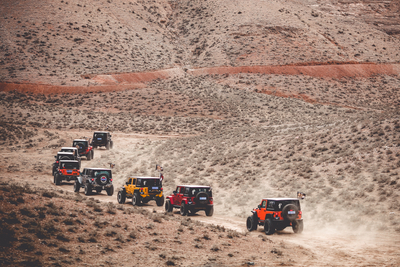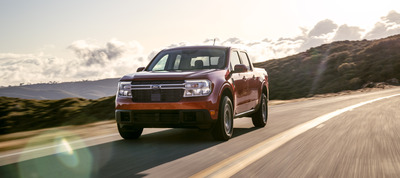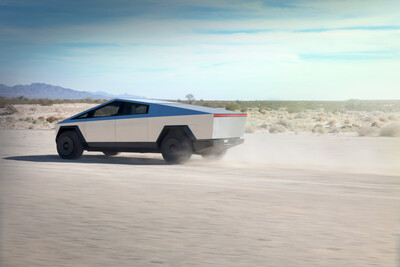BUSINESS
Truck and Off-Road Market Trends
Consumer Demand Continues for Pickups and Crossovers; Overlanding Remains a Growth Sector; Electrification Continues Apace
By Douglas McColloch

A resilient market sector, off-roading remains a popular automotive pastime. That’s never been more true than in the Age of Social Distancing. Land-access issues continue to pose a challenge for the future, however. Photo courtesy: Shutterstock
Consumer trends and preferences have changed many times over the years, but in the automotive sphere, pickups never really fall out of fashion. They’re the ideal multipurpose vehicles that are equally functional as daily commuters, jobsite workhorses or recreational trail toys. For sheer versatility, nothing compares to them on the road and off, and that’s probably why the bestselling vehicle in the United States for more than 40 years in a row has been a pickup.
More than half of all vehicles on the road in the United States are either pickups, SUVs or CUVs. According to the most recent issue of “SEMA Future Trends,” the light-truck segment (which includes pickups, vans, SUVs and CUVs) is forecast to account for close to 80% of all new-vehicle sales by 2027, with pickups alone making up nearly 50% of all new vehicles sold.
Healthy truck and SUV sales generally bode well for the automotive aftermarket. Parts and accessories for trucks and SUVs account for 30% of specialty-equipment sales, according to the latest “SEMA State of the Industry” survey, and that number has remained steady in the midst of the pandemic and its related economic disruptions. In fact, several segments saw appreciable sales increases over the previous year, with suspension, wheel and tire products all registering double-digit sales gains over 2020. Some segments—truck racks and carriers, bedliners and bed covers, and towing products—logged year-over-year sales gains of 25% or more. Off-road/oversize tires alone comprise a $2 billion annual market, so there is still ample consumer demand to keep the truck and off-road segment strong, even amidst a global pandemic.
New-vehicle sales in 2021 remained relatively flat compared to 2020, with an estimated 14.9 million units sold—a 2.5% increase over the previous year, according to Cox Automotive. Shortages of semiconductors kept inventories low for most of the period, and the year ended with roughly 1 million units on dealer lots, down from 3.5 million in pre-pandemic 2019.
More promisingly for the truck and off-road segment, pickups, SUVs and crossovers represented more than 80% of all new-vehicle sales in the month of December, according to J.D. Power & Associates. For the year, the top three best-selling vehicles in the United States were ½-ton pickups from Ford, Ram and Chevrolet, and seven of the top 10 U.S. best sellers in 2021 were either trucks, SUVs or crossovers.
For this article, we consulted a number of industry leaders for their perspectives on the overall state of the marketplace. What follows is a summation of their views.

Ten years ago, smaller midsize pickups were an afterthought. Now, with fuel prices higher and a new generation of truck buyers shopping on a tighter budget, vehicles such as Ford’s Maverick have been gaining popularity and market share. Photo courtesy: Ford Motor Company
New and Notable for 2023
A number of new trucks, SUVs and crossovers are set to hit the market within the next 12 to 18 months, including many all-electric and hybrid-electric models. Among them are:
Chevrolet
Avalanche: Based off GM’s T1 global chassis architecture, the all-new, four-wheel-independent Avalanche revives a discontinued marque as Ford has done à la the Maverick. The engine could be the 360hp 5.3L V8 that’s standard in the Silverado line or the optional 6.2L that produces 420 hp. An eight-speed automatic transmission is the likely standard gearbox, and MSRP should start around $30,000.
Colorado: The third generation of Chevy’s midsize will feature all-new exterior and interior styling as well as a revised powertrain lineup. The 310hp 2.7L LB3 turbocharged I4 sourced from the Silverado/Sierra ½-ton is the expected base engine, and it should be backed by a 10-speed automatic transmission. The I4 Duramax diesel and 3.6L V6 gas engine are said to be discontinued, and the truck should be available for sale by the second half of 2022.
Silverado EV: Chevrolet’s first all-electric pickup arrives for the ’24 model year sporting 660-plus hp, 400 mi. of range, a standard 6-ft. bed that can be extended to more than 10 ft. in length and a 10,000-lb. tow rating. The truck is said to share no componentry with the conventional Silverado, and an 800-volt charge capability is said to give it 100 mi. of range in only 10 min. Base MSRP will be around $40,000, though a fully optioned RST model may exceed six figures.
Ford
F-150 Lightning: First unveiled in May 2021, Ford’s first all-electric pickup comes to market delivering an estimated 563 hp, 775 lb.-ft. of torque and a 10,000-lb. towing capacity. Annual production was initially projected to reach 80,000 units by the ’24 model year, but demand was so strong that Ford was forced to stop taking preorders after receiving an initial 200,000 reservations for the truck. Originally set to launch last October, the vehicle is now set to officially go on sale this spring.
Maverick HEV: Slotting below the Ranger in the Blue Oval pickup line, the four-door Maverick HEV rides on the same unibody chassis as the Bronco Sport and Escape and is available in all-wheel drive. With a base-model MSRP below $20,000, demand for the small truck far outstripped projected factory output, and Ford announced last December that the truck’s initial production run was fully sold out for the 2022 calendar year. Preorders for ’23 will resume this summer.
Ranger: The new global-architecture Ranger replaces the eight-year-old Australian version that arrived here in somewhat revised form in 2019. The new model features all-new styling, an upgraded interior and a more refined ride. The base 2.0L twin-turbo powerplant is expected to carry over, with the 10-speed automatic transmission the likely gearbox. Ford has promised an electric Ranger in the not-too-distant future, so an all-EV or HEV model could be forthcoming. Base price is estimated in the mid-$20,000s.
GMC
Hummer EV: General Motors’ first all-electric pickup sports 1,000 max hp, a 300-mi. cruising range and an MSRP of $106,000. (Less expensive models will be available for 2024.) The truck will utilize four-wheel independent suspension with locking front and rear differentials and 35-in. mud-terrain tires. Air suspension and “CrabWalk” four-wheel steering are available options. Production begins in spring 2023.
Nissan
Frontier: The third generation of Nissan’s midsize will launch for 2023 with an all-new exterior, a more luxurious interior, and an upgraded suspension system. The 310hp 3.8L V6 will carry over from the previous year, along with a nine-speed transmission. Both Pro-X and Pro-4X models will be offered. The truck utilizes the existing chassis, so no gas-electric hybrid model is expected.
Titan: Mostly unchanged since its 2004 debut, Nissan’s fullsize emerges for 2023 with a more aggressive look, thanks to all-new sheetmetal and a substantially revised interior. The aging 400hp 5.6L V8 is said to be replaced by the more fuel-efficient 400hp 3.0L V6 sourced from the Infiniti Q60, which could also be offered with a hybrid-electric option. Given Nissan’s rumored partnership with EV startup Hercules Electric, an all-electric variant is a possibility as well.
Rivian
R1S: Fresh off the launch of its award-winning R1T electric pickup, Rivian is scheduled to roll out a seven-passenger, three-row SUV based off the same platform as the pickup. Slotted to compete against the Tesla Model X, the R1S offers an estimated 800 hp, a 0–60-mph time of 3.0 sec., 300 mi. of range and an adjustable air suspension that is said to provide as much as 14 in. of ground clearance. Estimated MSRP is around $70,000.
Subaru
Solterra: A joint venture with Toyota (which provided the battery and powertrain), the five-passenger Solterra is Subaru’s first-ever all-electric SUV. Two electric motors power the symmetrical X-Mode all-wheel-drive system, which controls throttle response, transmission shift points and torque transfer to optimize traction on wet or uneven terrain. Rated power for the Solterra is 215 hp and 248 lb.-ft. of torque, and the battery is said to accept an 80% charge in under an hour.

Scheduled to go into production early next year, Tesla’s highly anticipated 2023 Cybertruck is the latest example of the rapid electrification of the pickup sector. Photo courtesy: Tesla
Tesla
Cybertruck: Perhaps the most anticipated new truck arrival for 2023, Tesla’s stainless-bodied all-electric Cybertruck goes into production early next year at Tesla’s new assembly plant in Austin, Texas. Available with built-in solar charging to extend vehicle range, the Cybertruck will be offered in three trim levels, in rear-wheel or all-wheel drive, and with dual- and tri-motor drive configurations. Zero-to-60 acceleration is said to be as low as 2.9 sec., cruising range as much as 500 mi., and base MSRP an estimated $40,000.
Toyota
bZ4X: Short for “Beyond Zero,” Toyota’s first all-electric EV launches, along with its upscale companion, the Lexus RZ 450e, later in the year. A joint venture with Subaru (see Solterra above), the bZ4X will be available in either front-wheel or all-wheel drive and will offer a cruising range of up to 250 mi., opting for affordability at the expense of range. The Lexus variant, which shares the same TNGA global chassis architecture, will offer a more luxurious interior package, extended cruising range, and a heftier price tag.
Grand Highlander: Essentially a longer-wheelbase version of the Highlander, Toyota’s new three-row will slot above the Highlander and below the Sequoia in Toyota’s SUV lineup. Powertrains are likely to be the Highlander’s existing 3.5L V6, which produces 295 hp, and a 2.5L four-cylinder HEV. A diesel-electric hybrid may be offered at a
later date.
Tacoma: Redesigned for 2023, Toyota’s midsize is expected to sport a new coil-link rear suspension to deliver a more supple on-road ride, along with exterior styling cues taken from the all-new Tundra. The 3.5L V6 may be replaced by a version of the more fuel-friendly 275hp 2.4L I4 that’s used by the Lexus NX350.
Tundra: Largely unchanged since 2007, Toyota’s fullsize reemerges for 2023 as an all-new model. The gas-hungry iForce V8 is said to be going away in favor of a more economical 3.5L V6 that can be tuned to produce as much as 430 hp. A luxury “Capstone” model will feature 22-in. wheels, a 580 lb.-ft. hybrid-electric powertrain, and a price tag in the $60,000 range.
The State of The Industry: Pent-Up Demand, Record Growth
All of our industry experts agreed that the state of the truck and off-road market is robust, with opportunities for additional growth available through numerous
channels.
“The industry is still very healthy,” said Ted Wentz, CEO of Quadratec. “The entire industry experienced massive growth during the pandemic. We undertook years of growth in a period of around nine months.”
“There aren’t a lot of new cars entering the market anymore,” said Jenna Jefferies, national account manager for Pertronix Performance Brands. “We’re backordered for months on end—and growing, growing, growing.”
On a related note, PSC Motorsports COO Randall Speir noted the many new truck and SUV models, such as Chevrolet’s Colorado Trail Boss and Ford’s Ranger Raptor, that are more off-road-friendly in design than their predecessors.
“We have new entrants in the market, with Ford coming in and Chevrolet with some new things, and now Rivian,” he said. “We’ve got lots of new off-road-focused vehicles coming into the market, and that’s great, because they give us platforms we can use to make cool products for them.”
All of our experts similarly agreed that the combination of pandemic lockdowns, corporate work-from-home directives and government stimulus checks contributed to the growth of the sector.
“People wanted to get outside, and they had time on their hands to go outside with their vehicles and have fun with their families, so that played a big part in it,” Speir said.
“At the beginning of the pandemic, there was a bit of a growth in replacement parts as people were just trying to keep their vehicles running and didn’t necessarily feel comfortable going to shops,” Wentz said. “Now we’re seeing growth in categories that support an outdoor lifestyle.”
From a business perspective, the pandemic also gave many companies a chance to reevaluate and reassess their existing sales and marketing models and to make adaptations to changes in the marketplace.
“With the pandemic, everybody had an opportunity to sit down at their desks, take a breather, think about what they could do differently, and now they’re bringing great things to market,” said Charlene Bower, owner of Bower Motorsports Media. “As business owners, we’ve all had a chance to review what we’ve been doing and see what we need to continue and what we need to redevelop—from services to products to everything in between.”
Perhaps because of that, she added, “I saw more innovation at the 2021 SEMA Show than I have seen in years.”
Digital Resources: The New Media Landscape
The COVID-19 pandemic posed a unique challenge for businesses that rely primarily on a retail presence: How do you reach your customers when they’re sheltered at home? For the truck and off-road aftermarket, the answer was online content and social media.
Besides running her own media company, Bower also heads Bower Academy, an educational program that provides hands-on instruction for women in subjects ranging from off-road driving and vehicle maintenance and repair to principles of Tread Lightly! and other topics. When the pandemic hit and indoor hands-on learning wasn’t feasible, “I took a nap for two weeks to think about what I could do differently with my business,” she said.
“I rotated all my educational programs online as opposed to being in-person. We have online classes now through Bower Academy, which includes how-to classes, and I was able to turn my backyard into an area where girls can learn and train.”
Along with providing online content for customers, many companies learned to leverage the power of social media to maximize consumer outreach.
“While face-to-face and meeting at events are the best ways to interact with customers, social media is an extension of word-of-mouth with photos,” Speir said. “People want to be a part of something, so it’s great that we have a social network and that we have Facebook Groups and things that are around our industry. It’s becoming a big part of promoting our brand.”
Social media is huge, Wentz agreed. “It’s another touchpoint to communicate with your customers and to create a community,” he said. “As the younger generations move up in the workforce, they’re generating capital, and they’re ready to go have some fun with their vehicles. If you want to communicate with those folks, you need to find a way to do so in the channels they’re comfortable with.”
While acknowledging social media’s brand-building potential, Wentz also offered a word of caution when dealing with a form of media that’s still rapidly evolving.
“TikTok is big right now, and for now, that’s the big growth channel,” he said. “What we tend to see with these new social-
media outlets is that sometimes they go up in popularity really quickly, and sometimes they stay popular and sometimes they don’t. You have to be cautious about how you invest in these things and make sure you don’t overcommit to something that isn’t going to be around tomorrow.”
Bower took a similar outlook, preferring to stick with a proven platform.
“It’s a great way to get free exposure,” she noted. “But it’s also very volatile, with a lot of political issues that have caused us to drop a lot of people on social media. If you don’t have a great marketing case, social media isn’t always the best way to reach people,” adding that “I’m a Facebook girl.”
One form of content that our experts agreed has proven effective is event coverage.
“When we post to social media, it’s always the events and videos about events that get the most response,” Speir said. “People were really hungry for that—the desire to see people out there, utilizing their vehicles, and be a part of that even if they can’t get out themselves.”
Outdoor Lifestyles: Opportunities for Growth
On the subject of events, Bower exclaimed that crowds are coming out to the races again.
“The crowds at Crandon [International Off-Road Raceway] for the World Championships were the biggest they’d ever been,” she said. “I know there are still some challenges with crowd capacity, but as time continues, we’ll see racing fans coming back because they’ll realize what they’ve been missing.”
All of our sources also agreed that the steady popularity of overlanding remains a bright spot in the market. First popularized in Australia, the hobby caught on quickly in South America and Sub-Saharan Africa before catching fire in North America, where it has grown exponentially over the past decade and a half.
Due to its overlap with numerous outdoor lifestyle activities, it’s difficult to measure overlanding’s market growth precisely in dollars and cents. However, the global adventure tourism market—which includes camping, hiking, mountain biking, kayaking and other pursuits that are closely associated with overlanding—enjoyed a boom in the 2010s and is forecast to grow in value from $112 billion in 2020 to $1.17 trillion in 2028. The 30-to-40 age demographic is the most heavily invested in the market, according to a recent report by Allied Market Research.
One element that’s possibly contributing to overlanding’s growing popularity is its inclusivity. While it’s certainly possible to spend a great deal of money to outfit a vehicle for overlanding (some adventurers will spend upward of six figures on their rigs), it can also be done on a reasonable budget. One need not possess a heavily modified trail machine. In fact, a Subaru Crosstrek or a Dodge Sprinter cargo van can be converted into a capable backcountry explorer with just a few basic modifications, including more aggressive tires, upgraded shocks, some extraction equipment, and an assortment of camp gear.
“It’s not just overlanding,” Wentz said. “It’s whatever you can use on your vehicle to enjoy being outside. Overlanding’s a part of that, sure, but anything to do with biking or hiking or fishing [is becoming popular]—any of those things you can do outside and that allow you to accessorize your vehicle to help achieve that.”
“We’re also seeing some movement in the crossover segment—Subarus for one—and that is bringing new customers to our industry.” Speir said.
That said, overlanding is still a huge deal, Jefferies said, noting that the Jeep market is still going, and the Bronco market is taking off.
“Work-from-home options during the pandemic gave people the opportunity to go adventure while still being successful at their businesses, and I see that trend continuing going forward,” Bower added.

Still a promising growth sector, overlanding remains a hot consumer segment, and accessories that can convert SUVs and crossovers into “outdoor lifestyle vehicles” are an additional market driver. Photo courtesy: Shutterstock
Future Challenges and Opportunities
Nearly all of our experts said that staffing issues pose the greatest potential obstacle to growth in the short term.
“Right now, the labor shortage is a real problem,” Wentz said. “I’ve never seen anything like it.”
Speir agreed. “We’re not finding enough people who want to work,” he said. “The pandemic may have changed the way some people feel about life and changed their priorities, and that may have had an effect on the job market. Hopefully, we’ll see some additional influx into technical schools where kids are actually working on vehicles and falling in love with working on them, and that will refresh out talent pool. Getting involved in educating the future of our industry is a tremendous opportunity.”
Jefferies concurred, adding that it’s crucial to get the youth involved in the market.
Supply-chain issues also pose an ongoing challenge, although Wentz sees signs of improvement in the not-too-distant future.
“I’m seeing some signs that there could be some normalization coming at some point in 2022, but I think we’re going to have to ride this supply-chain issue for a while,” he said. “It’s definitely a challenge.”
A further potential problem facing the off-road side of the market is maintaining access to public lands.
“That’s one of our biggest issues at the Truck & Off-Road Alliance,” Speir said. “We must make sure that people take care of the land and that we don’t lose our access.”
For companies and individuals wondering where they should target their resources, Speir noted that the greatest progress with land use will be at the state level.
“I think that’s really where we’re going to make the most impact, and that’s our focus right now,” he said.
Bower uses her experience as a master trainer for Tread Lightly! to promote responsible off-road practices.
“Land use and land access are very important now,” she said. “Education is the key element to helping people understand what we need to do to be responsible recreationalists to keep our trails open. From a business perspective, none of us would be standing here if we didn’t have trail access, and from the consumer and overland perspective, we can’t get out there if we don’t have trails open. It should be everybody’s position to get behind these initiatives and make sure everybody is doing a great job.”
Jefferies also noted the rapid growth of electrification in the truck sector and the need to keep up with the latest OE technologies.
“I think EVs are a huge thing that we’ll need to get adjusted to, and that will require adaptation by our industry,” she said.
More than 1.2 million HEVs or EVs were sold in the United States in 2021, a 75% increase over 2020 and a combined 8% of all new-vehicle sales. Still, our panel believes that the foreseeable future is still relatively bright for the industry. Wentz offered this advice for businesses looking to increase their market presence in the coming year:
“From an opportunity perspective, the industry has acquired more customers over an 18-month period than it has ever had before. What are we going to do with those customers? What are we going to innovate for them? What are we going to do to keep them interested in our brands? Those are the kinds of questions we need to be asking ourselves if we want to take advantage of this growth opportunity that’s right in front of us.”
About the Truck & Off-Road Alliance
The Truck & Off-Road Alliance (TORA) represents the collective interests of its members through a single, powerful voice that can play a significant role in shaping the industry. The membership joined together to form a potent coalition whose mission is to determine the shape and future of the truck and off-road accessory industry. TORA is a council whose member companies manufacture, distribute, sell and/or install accessories for off-road vehicles, light-duty pickups or ATVs, or provide services to the off-road or truck accessory industry. To learn more about TORA and SEMA’s other industry councils, visit www.sema.org/get-involved.






